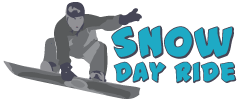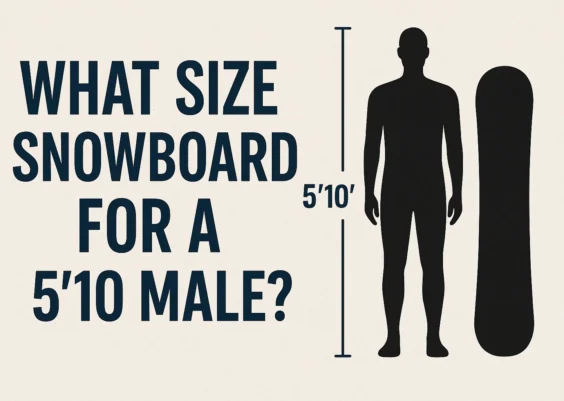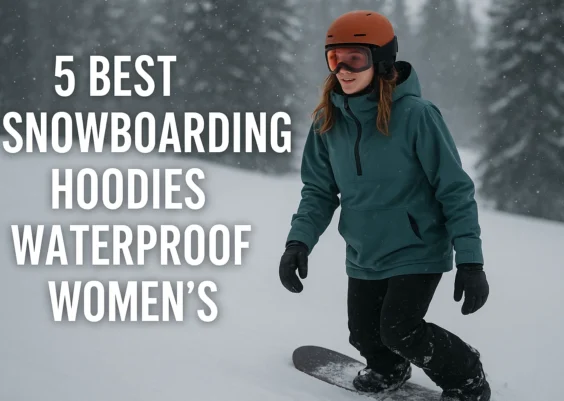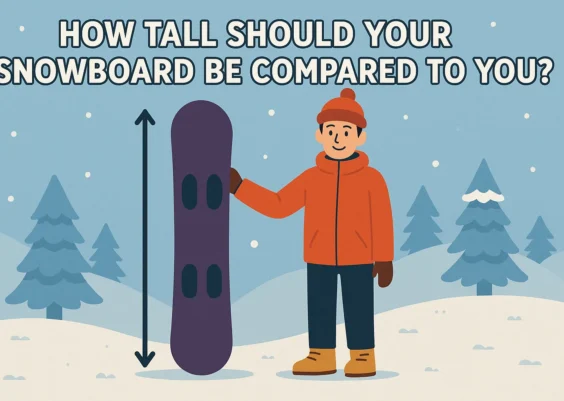Quick Facts About Female Snowboard Size
- Most women’s snowboards range between 139 cm and 154 cm in length.
- Rider weight is the most reliable factor when matching board size.
- Waist width for women’s boards usually falls between 226 mm and 248 mm.
- Shorter boards give more control for beginners and freestyle riding.
- Longer boards provide better stability for speed and powder.
The right female snowboard size depends mainly on body weight, height, and riding style. A properly sized board makes turning easier, gives you better balance, and helps you ride with confidence. Most women’s snowboards fall between 139 cm and 154 cm, but that doesn’t mean every rider should pick within this range.
Your riding goals and board type also play a role in the final choice. Choosing too long or too short can affect control and performance. So how do you know exactly which size will fit you best? Let’s break it down step by step.
Women’s Snowboard Size Chart
Snowboard length is often matched with rider weight and waist width.
| Board Length (cm) | Rider Weight (lbs) | Waist Width (mm) |
|---|---|---|
| 139 – 141 | 80 – 130 | 226 – 231 |
| 142 – 144 | 90 – 140 | 229 – 233 |
| 145 – 147 | 100 – 150 | 235 – 237 |
| 148 – 149 | 110 – 160 | 238 – 241 |
| 150 – 152 | 110 – 170 | 241 – 244 |
| 153 – 154 | 120 – 190 | 245 – 248 |
US Women’s Boot Size → Snowboard Waist Width
| US Boot Size (Women) | Recommended Waist Width (mm) |
|---|---|
| 5 – 6 | 225 – 235 |
| 7 – 8 | 236 – 242 |
| 9 – 10 | 243 – 248 |
| 11+ | 249+ |
How to Read and Use the Chart
- Start with rider weight. Find the row where your weight sits near the middle. That length will feel balanced for most riders.
- Pick a starting length. If you see a range, choose the middle. Go 2–3 cm shorter for park and beginners. Go 2–3 cm longer for speed, powder, or stability.
- Match boot size to waist width. Use the boot→waist table. Aim for about 5–10 mm of toe and heel showing past the board edge on each side when mounted. That gives clean edge hold without boot drag.
- Height is secondary. If you are tall for your weight, lean to the longer end of the row. If you are shorter, lean to the shorter end.
- Check if you need “wide.” Women’s wide boards often start around 244–248 mm. Consider wide if you ride US 9.5–11 boots or get boot drag at low binding angles.
- Binding angles affect clearance. More angle creates more clearance. If you ride low angles and see drag, choose a few mm wider.
Example 1: 135 lbs, US 7.5 boots → length 144–146 cm, waist 236–242 mm.
Example 2: 160 lbs, US 9 boots → length 149–152 cm, waist 243–248 mm.
How to Find the Right Snowboard Size for Women?
Finding the right snowboard size is not about guessing. It is about matching body weight, riding style, and other key details like width, shape, and flex.
Body Weight and Board Length
Weight has the strongest link with board length. Heavier riders need longer boards to support pressure, while lighter riders do better on shorter boards for easier turning.
Recommended Board Length by Weight
| Rider Weight (lbs) | Suggested Length (cm) |
|---|---|
| 80 – 100 | 138 – 141 |
| 100 – 120 | 142 – 145 |
| 120 – 140 | 145 – 147 |
| 140 – 160 | 147 – 150 |
| 160 – 180 | 151 – 154 |
| 180+ | 155+ |
Tips:
- Stay close to the middle of your weight range for all-mountain riding.
- Go shorter if you are learning, want quick turns, or ride in parks.
- Go longer if you focus on powder, speed, or carving.
Riding Style and Snowboard Size
Your style of riding changes the right size by a few centimeters.
- Freestyle / Park: Pick a board 2–4 cm shorter than your standard length. Example: if 147 cm is ideal for your weight, go for 143–145 cm for park riding.
- All-Mountain: Stay in the middle of your weight-based size chart. Balanced for mixed terrain.
- Freeride / Powder: Choose a board 2–4 cm longer than standard. Longer boards float better in deep snow and stay stable at speed.
Other Factors to Consider
Board Shapes
- True Twin: Same nose and tail. Great for freestyle and beginners.
- Directional: Longer nose than tail. Better for speed and carving.
- Directional Twin: Mix of both. Good for all-mountain riders.
Snowboard Width
Width prevents toe and heel drag. Match waist width to boot size.
| US Women’s Boot Size | Ideal Waist Width (mm) |
|---|---|
| 5 – 6 | 225 – 234 |
| 7 – 8 | 235 – 241 |
| 9 – 10 | 242 – 248 |
| 11+ | 249+ |
Quick Tip: Stand on your board with boots mounted. Look for about 1 cm of boot overhang on each side.
Flex
Flex affects control and response.
| Flex Rating | Feel | Best For |
|---|---|---|
| Soft (1–3) | Easy turns, forgiving | Beginners, park, casual riders |
| Medium (4–6) | Balance of control and stability | All-mountain riders |
| Stiff (7–10) | Strong edge hold, fast response | Freeride, racing, advanced riders |
Tip: Lighter riders should avoid stiff boards because they may feel hard to control.
Examples of Rider Profile
| Rider | Height | Weight | Boot Size (US Women) | Riding Style | Suggested Board Length | Suggested Waist Width |
|---|---|---|---|---|---|---|
| Emma | 5’2″ | 110 lbs | 6 | Beginner / Freestyle | 142 – 144 cm | 226 – 234 mm |
| Sarah | 5’5″ | 135 lbs | 7.5 | All-Mountain | 146 – 148 cm | 236 – 242 mm |
| Laura | 5’7″ | 155 lbs | 9 | Freeride / Powder | 150 – 152 cm | 243 – 248 mm |
Summary
- Emma is lighter, so a shorter board makes learning and tricks easier.
- Sarah rides all-mountain, so a mid-length board keeps balance across terrain.
- Laura rides powder and freeride, so she benefits from a longer, stiffer board.
Is There Any Difference in Men’s and Women’s Snowboards’ Size?
While both boards serve the same purpose, women’s snowboards are designed with specific adjustments for body structure, weight distribution, and boot size. These changes improve comfort and performance for female riders.
Men’s vs. Women’s Snowboard Size and Design
| Feature | Women’s Snowboard | Men’s Snowboard |
|---|---|---|
| Length Range | 139 – 154 cm (on average) | 150 – 165 cm (on average) |
| Waist Width | 226 – 248 mm (narrower for smaller boots) | 240 – 260+ mm (wider for bigger boots) |
| Flex | Softer flex to match lighter body weight | Stiffer flex for heavier riders |
| Stance | Narrower stance options for shorter legs | Wider stance options |
| Boot Fit | Designed around US Women’s sizes 5–10 | Designed around US Men’s sizes 7–13+ |
| Weight Range | 80 – 180 lbs supported | 120 – 250+ lbs supported |
Can women ride men’s boards?
Yes, but only if the sizing matches. A woman with larger feet (US 9.5+) may find a men’s board better because of its wider waist. On the other hand, smaller riders may struggle with men’s boards as they feel stiff and less responsive.
FAQs About Female Snowboard Size
1. What size snowboard should a beginner woman use?
Beginners should pick a board on the shorter side of their weight range. Shorter boards are easier to turn and control.
2. Does height matter as much as weight in snowboard sizing?
Weight is the main factor. Height only helps fine-tune the choice when you are unusually tall or short for your weight.
3. Should women use a narrower board than men?
Yes. Women’s boards are built narrower to match smaller boot sizes. Narrower boards help with quicker edge-to-edge control.
4. How do boot sizes affect snowboard width?
Boot size directly affects waist width. A mismatch can cause toe or heel drag, or make the board hard to control.
5. Can women ride men’s snowboards?
Yes, if the length and width fit. Women with larger feet or heavier body weight may prefer men’s boards.
6. What happens if I choose the wrong snowboard size?
A board too long feels heavy and hard to turn. A board too short feels unstable at speed. Both can slow down progress.
7. What flex rating is best for women beginners?
A soft flex board (1–3 rating) is easier to learn on. It forgives mistakes and allows smoother turns.
8. Do women need wide snowboards?
Only if boot size is US 9.5 or larger. Otherwise, standard waist widths are usually enough.
Choosing the right female snowboard size is less about rules and more about fit. Your comfort on the slopes comes from how well the board matches your riding goals and body mechanics. A size that feels natural under your feet will boost confidence, reduce fatigue, and make every run more enjoyable.
The best way to find that size is to use charts as a guide, then test boards when possible. Once you discover the length and width that match your style, the mountain feels like it’s built for you.




